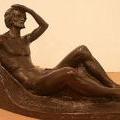 Celebrated Quebec sculptor and painter Albert Laliberté was born in Ste-Élisabeth-de-Warwick in 1878. At the age of eighteen, he went to Montreal to study at the Société des arts and the Conseil des arts et manufactures. It was upon the advice of Sir Wilfrid Laurier that Laliberté's father allowed him to go to Montreal, and appropriately, it was for a life-sized bust of Laurier that Laliberté won first prize at the Provincial Exhibition in Québec City at the age of 20.
Celebrated Quebec sculptor and painter Albert Laliberté was born in Ste-Élisabeth-de-Warwick in 1878. At the age of eighteen, he went to Montreal to study at the Société des arts and the Conseil des arts et manufactures. It was upon the advice of Sir Wilfrid Laurier that Laliberté's father allowed him to go to Montreal, and appropriately, it was for a life-sized bust of Laurier that Laliberté won first prize at the Provincial Exhibition in Québec City at the age of 20.
In 1902, with the help of his patrons, Laliberté went to Paris to study art at the École des beaux-arts. While in Paris, Laliberté first saw the works of sculptor Auguste Rodin. He also participated in several exhibitions and met fellow Townships artist Aurèle de Foy Suzor-Coté, a native of Arthabaska, which was not far from Laliberté's own home town. The two would become lifelong friends.
Upon his return to Montreal three years later, Laliberté was awarded a teaching position at the Conseil des arts, where he had studied. His first important solo exhibition was with the Art Association of Montreal.
Laliberté enjoyed a prolific career as an artist. A member of the Sculptors' Society of Canada from 1933, his known works include over 900 sculptures in bronze, marble, wood, and plaster, as well as several hundred paintings. He was awarded a number of public commissions, including monuments to Laurier, Dollard des Ormeaux, and French Canadian pioneer Louis Hébert. He is known, however, for his busts and his religious and allegorical sculptures, the latter influenced heavily by the work of Rodin. He is best known for his highly acclaimed series of 214 small bronzes that celebrate the legends, customs, and trades of rural Quebec, and which were based on what he saw in his native Eastern Townships. Like other artists of his time, Laliberté was profoundly attached to his native province and its history. He died in Montreal in 1953.